Once your child moves from the baby to the toddler stage you may wonder what you have done wrong!
You may start to see the temper tantrums and the start of the word ‘No’ in their vocabulary!
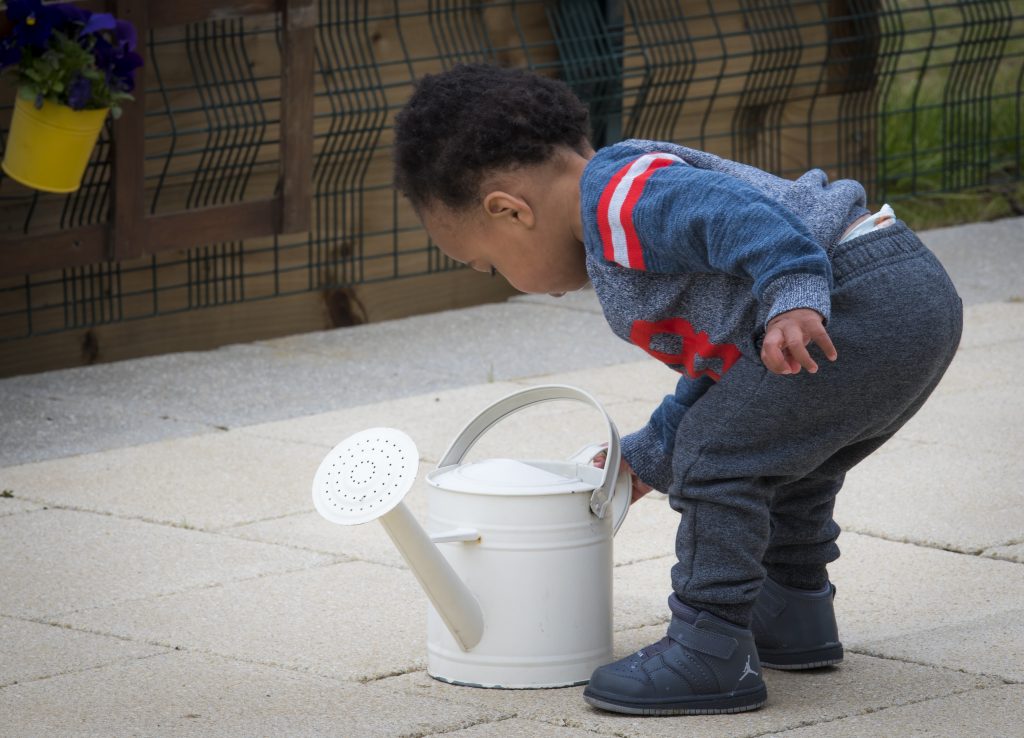
Parents Sculpt Brains
90% of the growth of the human brain occurs in the first five years of life. So the time we spend sharing and responding positively to our young children will forge connections between the brain cells. These connections help our children cope well with stress and emotional situations later in life.
This video explains more:
Tips for Effective Brain Development
1. Positive attention
Children need lots of positive attention to develop their brains.
2. Special moments Sharing special moments with your child develops the emotional part of the brain to them feel safe, loved and good about themselves.
3. Time to play
Play encourages creativity, curiosity and interest in the world around them, which is essential in developing the ‘seeking system’ in the brain. This activates the drive and energy needed for life.
4. Rough and tumble
Rough and Tumble is a natural way of helping your child’s brain to manage emotions and to adapt to others.
5. Cuddles galore
Cuddles are vitally important for brain connections to happen. the more touch your child gets in childhood, the calmer they are likely to be as an adult.
6. Feelings and listening
Help your child with his big feelings by really listening to them and naming their feelings in their language they can understand.
7. Enthusiasm and Energy
Be really enthusiastic and interested in what your child is doing. Meet their joyful energy with your joyful energy.
8. Time in
Time in with your child rather than ‘time out’ will help you better understand why your child is behaving negatively.
9. Clear boundaries
Your child needs to be taught what is acceptable or unacceptable behaviour by giving clear boundaries and using choice and consequence to develop the rational part of their brain.
10. Breakfast
A protein-rich breakfast is essential to your child’s brain to cope with stress and anxiety. Encourage healthy eating habits as soon as possible.
Source: What every parent needs to know by Margot Sunderland.
You can download a PDF handout of the above below:
Parents sculpt brains – Handout
Tips for effective brain development – Handout
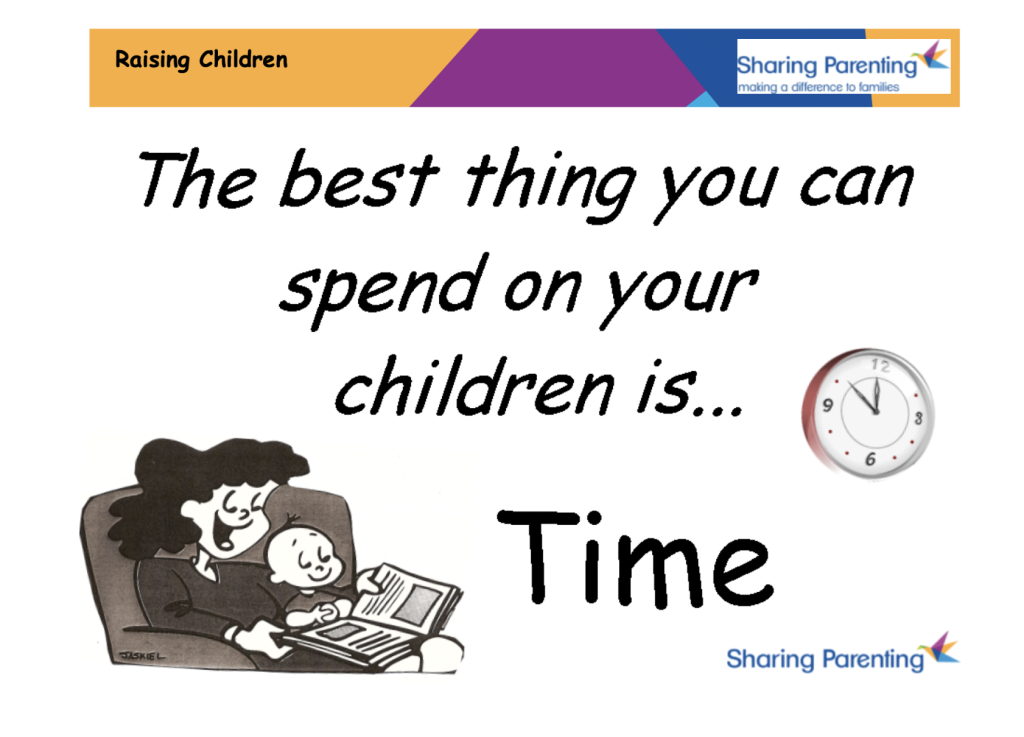
Whilst your toddler is going through major brain changes which will help them in the future they will need to learn to wait, take turns, sometimes accept that they can’t have or do something.
Whilst they are learning it will take a lot of patience, time, repetition and energy to help them get it right.
Safety First
As parents and carers, our first job is to keep them safe. Always keep that in mind when you are teaching them – and sometimes you will be able to explain why they can’t do something. ‘You need to hold my hand near the road so I can keep you safe’ etc.
What is normal?
We don’t like to use the term ‘normal’ as what is normal for one family may be very different for another. However, these are some of the things you can expect from a two year old:
- Are learning to be independent but get frustrated easily
- Are possessive (they think they are the centre of the universe)
- Are noisy
- Can’t sit still for long
- May stop sleeping during the day, but will often be tired
- early evening
- Have a short memory
- Play beside other children, not with them
- Have tantrums
- May go through another stage of separation anxiety
Emotional Overload
 With your help, you will help your toddler make new connections in their brain. When we are born we react primarily to the front part of our brain. This is necessary for survival, to help us get food etc. when we can’t do it for ourselves.
With your help, you will help your toddler make new connections in their brain. When we are born we react primarily to the front part of our brain. This is necessary for survival, to help us get food etc. when we can’t do it for ourselves.
As we mature we need to learn to connect to the part of our brain which will help us learn empathy, wait patiently, understand the world from another point of view, deal with angry feelings without lashing out to others etc.
How you can support them: Ways to avoid emotional overload
- Distract your toddler before they get too distressed. “Look at that tree, cat, flower etc.”
- Give choices. People feel frustrated when they feel powerless. Giving two options gives them power. For example, a child who refuses to get dressed, ask them “Would you like to wear your red jumper or your blue coat?” It is important to stick to two (or three) choices at the most, so they don’t feel overwhelmed.
- Create a calm are area in the house. A small pop up tent with pillows and blankets can be a great place for your toddler to calm down and reset. Somewhere with limited stimulation and where it is quiet and not too bright.
- Use mood bottles to help them concentrate onto one thing – almost like a meditation.
Needs – Fill your jug first
 To be able to look after your children you need to look after yourself. Remember the age old saying ‘You can’t pour from an empty jug’?
To be able to look after your children you need to look after yourself. Remember the age old saying ‘You can’t pour from an empty jug’?
Well this applies to you too. If you ever listen to the emergency announcements before take off on a flight on an aeroplane you will notice they ask you to put your own oxygen mask on first. Have you ever wondered why this is?
How you can support them
If you look after yourself first you will be in a much stronger position to help many others around you. Some people may think this is selfish but actually the opposite may be true.
What can you do for yourself to fill your jug?
Take a warm bath, go for walk, talk to a friend, read a magazine, sit and drink a coffee, meditate, go for a run etc.
Need behind the behaviour – Maslow’s hierarchy of need
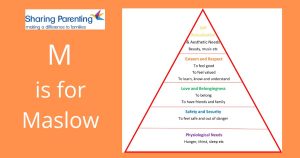 When we see challenging behaviour we need to think about what the reason is for the behaviour. Often when we see challenging behaviour is it to satisfy an unmet need.
When we see challenging behaviour we need to think about what the reason is for the behaviour. Often when we see challenging behaviour is it to satisfy an unmet need.
Have you ever wondered why you can’t concentrate on anything when you are hungry or tired?
Maslow’s theories are shown on a triangle. He said unless the NEEDS at the bottom are addressed you cannot move up the triangle.
This would explain why children are often moody when they come out of school – they are tired and need feeding! I had a friend who greeted her twins with a banana each when she picked them up from school – she knew what they needed and how to avoid challenging behaviour on the way home!
This is also why it may take a while for children (and adults) to settle in to a new house, group or job.
At first they may feel unsafe with the unknown or unfamiliar or that they don’t belong – once they start making friends and getting to know a new space just watch them thrive.
How you can support them
When you see challenging behaviour – stop and think – where are they on Maslow’s triangle?
Start at the bottom and work up.
Needs – behaviour has a purpose.
 It is important to share the people behind the research before we begin.
It is important to share the people behind the research before we begin.
Alfred Adler (1870-1937), was an Austrian psychotherapist working in Vienna at the same time as Freud. He was one of the first psychotherapists who was interested in the relationship between parents and their children and individuals and society.
Adler recognised that every action of a child has a purpose and that the child’s basic aim is:
- to have significance,
- to feel they belong and
- have a place in their social group.
He concluded that a child who is misbehaving is trying, in their own way, to get their needs met, to find their place and to feel important in their own world.
Adler identified four goals of misbehaviour:
- Attention seeking
- Power seeking
- Revenge seeking
- Giving up
Betty-Lou Bettner and Amy Lew are American psychologists who practise, teach and write using Adlerian principles and came up with the idea of the CRUCIAL C’s to help parents to understand and remember the goals of misbehaviour.
The Crucial C’s are
- Connect – I need to believe I belong
- Capable – I need to believe I can do it
- Count – I need to believe I can make a difference
- Courage – I need to believe I can handle what comes
The clue to their need and the best way to respond
How you can support them
The best way to work out what your child needs by their behaviour, is to ask yourself how their behaviour makes you feel?!
CONNECT
When you are feeling irritated by your child it is usually because they are looking for your attention because they need to connect.
Even though you may not be able to give it right away (and you do not want to reward negative behaviour), make a note that they are asking for someone to one time and plan it as soon as possible.
CAPABLE
If you feel angry or feel like you are getting into a power struggle with your child it’s usually because they don’t feel capable of doing something.
Give them choices (and get out of the ring) and plan some time to actively listen to them.
COUNT
If you feel hurt by something your child has said (or keeps saying) it may be because they don’t feel they count (or valued) in some way.
Tell them what you really like about them and be specific about positive behaviours. Actively listen them and include them in family decisions – for example, let them choose a meal or dessert for the family each week.
Encourage
If you feel like giving up, it is likely your child feels like giving up too 🙁
Give them COURAGE. Start small and build on the positives.
Encouraging words and actions during the process will have a big effect on your child’s self esteem and their motivation to carry on or have the courage to start something new.
Learning to have a go even if they do not always succeed (or be the best) at something are good skills for life.
Focus on the effort that your child is putting into something (however small rather) than the end result.
Active Listening
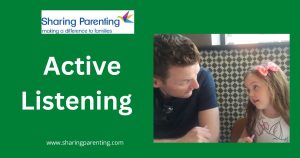 Research tells us there is a link between active listening and self esteem. We aren’t taught to listen, we ‘just do it’. Some people are better than others. Sometimes as parents, things get in the way and we can be distracted when our children are trying to talk to us.
Research tells us there is a link between active listening and self esteem. We aren’t taught to listen, we ‘just do it’. Some people are better than others. Sometimes as parents, things get in the way and we can be distracted when our children are trying to talk to us.
Listening does not mean fixing, it means supporting our children to work things out.
Encourage them and build their self esteem.
There are 2 levels of listening:
- What the words are telling you
and
2.What your child is feeling. It is important to hear on both levels.
How you can support them: How to Actively listen:
Use open body language
What does this mean? (I’ll give you a clue – the OPPOSITE of someone on their phone!)
Think about someone you like to talk to – someone who is there for you.
Are they looking at you, is their body facing you, are they nodding (and really listening) to what to what you are saying?
Do they ask open questions like ‘How do you feel?’, ‘What do think about that?’ etc rather than talking about themselves.
If you can do this for your children you will keep the communication open between the two of you – and help them to problem solve.
Other helpful tips
- Make a conscious decision to listen
- Switch off your own agenda
- Ask open questions (who, what, where, when, how)
- Think of your body language – open posture, nodding, facing child, eye contact when you can.
- Resist giving advice. Remember – you’re not fixing.
- Listen for their feelings (e.g it sounds like you’re really angry)
- If it isn’t an appropriate time for you to listen, make an arrangement with your child to find a suitable time. Make sure you stick to it.
- Think about how it feels when you are not listened to compared to how you feel when you are being listened to.
- Mirror good listening to show your children how to become good listeners.
The best thing you can spend on your children is time
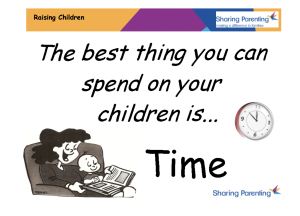 90% of the growth of the human brain occurs in the first 5 years of life. So the time we spend sharing and responding positively to our young children will forge connections between the brain cells. These connections help our children cope well with stress and emotional situations later in life.
90% of the growth of the human brain occurs in the first 5 years of life. So the time we spend sharing and responding positively to our young children will forge connections between the brain cells. These connections help our children cope well with stress and emotional situations later in life.
Don’t say don’t

Try this simple but effective positive parenting strategy to turn around challenging behaviour. This one’s called ‘don’t say don’t’ and has been really helpful parents.
If I say to you “don’t think of a rabbit, don’t think of its big ears, don’t think of its fluffy tail and please don’t think of a white rabbit”
What do you think of? ….. a rabbit exactly! It’s really hard not to – it’s just how our brains work. If we say don’t it almost visualises that. Don’t becomes silent and you hear the do at the end.
When you’re speaking to children if you think about the last two words that you’re saying, those are the words that they’re most likely to hear and act on.
Also, are when we say those two words our brains will kind of form a visual image of that, so if it’s negative then they form the visual image of the negative.
If we say “don’t hit me” they’re likely to hit you because they just hear “hit you” or if you say “don’t bite” then they just hear “bite”!
How you can support them
Instead of “don’t bite” you could say “stroke my arm” or “let’s look at this …” or “just take a moment, take a breath” and things like that so they hear the positive way. Just try to be really positive about it and if you hear yourself saying don’t, it’s fine, just follow up with the positive.
Labelling
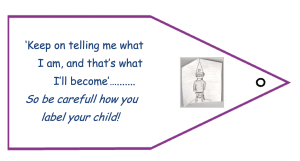 Do you have a little queen or princess at home? Or maybe a little monkey!
Do you have a little queen or princess at home? Or maybe a little monkey!
If you have felt a connection from a relative who has also ways had a nickname for you then this can be a positive thing. However, labels can be restrictive (even if you don’t mean them to be).
For example does a little princess feel permission to climb trees, play with mud, join in with the games at Forest school or messy play? Does the little monkey sometimes want to be recognised for sitting still, concentrating, reading a book or playing quietly?
With a label it is easy for them and others to make assumptions about the person we are labelling.
Remember also if we are given a label it is sometimes easier to live up to it. That’s often why ‘naughty children’ just carry on with naughty ways – they have been given permission without you realising it.
How you can support them: So, what can you do instead?
It is always better to describe the ‘behaviour’ not the person (or the deed not the doer).
Eg: That was a ‘naughty thing’ is better than you are naughty. Or she enjoys playing football rather than ‘she’s the sporty one’. This then opens the options for children to explore – the girl who enjoys football might want to try her hand at art or the boy who is often quiet might want to join in with a noisy activity and this can support them to do so.
Schemas
 Have you noticed your child obsessing over wheels or running in circles one week and then lining up their cars the next? This may be because of a schema.
Have you noticed your child obsessing over wheels or running in circles one week and then lining up their cars the next? This may be because of a schema.
Schemas are a form of repetitive play children are driven to engage, which helps their cognitive development. This type of play can seem unusual to adults but is seen consistently with children at certain stages of their development.
At a year, children will often try putting objects inside other objects, even get inside them themselves (or try to). These schemas seem to help them make sense of the world.
How you can support them
Allow your children to experiment and play repetitively.
Learn more about Schemas so you can recognise and support them.
- Child-led play
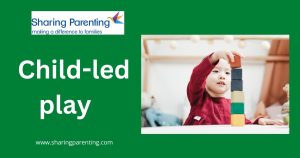
Research has shown that adults who can play with their child for at least 15 minutes and day benefit by:
- Enjoying their child more
- Can settle difficult behaviours
- Helps stimulates creativity and imagination
- Their child can play better on their own at other times
- Can help child sleep better
What is child led play?
This means letting your child lead the play.
The adult can state what they see but does not ask lots of questions.
Adult sits at the child’s level or on the floor with no other distractions (turn the phone and TV off!)
Adult focuses only on the child – one activity only.
Watch the clip below to find out more: http://vimeo.com/6016065 (Copy and paste into your browser if the link does not work).
How?
- Choose a toy or special box of toys for your child to play with.
- Plan a quiet time of the day when you or your child is not tired or hungry or you will be interrupted.
- Turn off the TV, phones and computers.
- Set a timer for 15 minutes.
- Sit on the floor or at your child’s level.
- Watch and listen – name if you want to ‘ you have picked up a red car and now a blue car’.
In Summary

How you can support your toddler
- Expect challenging behaviours and plan for them – have toys to distract them (especially when out), give choices, create calm areas in the house.
- Take time out for yourself when you can
- Offer food and drink regularly
- Be aware of your toddler’s needs – if they are tired you should expect challenging behaviour
- Give them 1 to 1 time (even if it’s 15 minutes a day)
- Encourage them ‘That was a good thing you did’
- Listen to your child and let them lead the play
- Label the behaviour not the child. ‘That wasn’t a kind thing to do’
- Be aware of schemas and allow repetitive play.
More information, positive parenting strategies and downloads can be found at www.sharingparenting.com
If you are concerned about your toddler’s behaviour speak to your GP or Health Visitor.
Positive Strategies
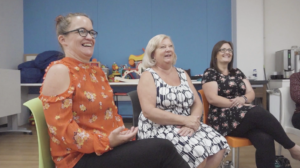
See our full list of positive strategies HERE
Here is a list which may be most relevant to parents of toddlers:
15. Top Tips for a Bedtime Routine
Day time and Night time wetting
6. Stories without books can be educational (and fun) too!
8. Parenting a child with English as an additional language
13. Flow chart to find the NEED behind the behaviour
16. Do You Have a Fussy Eater?
25. Filling YOUR jug – taking care of YOU – so you can take care of them
27. Don’t say don’t!
35. Learning through play
44. Catch them being good
38. Why do I always feel I am failing as a parent? (Podcast)
Further Resources
Please click on the links below for further external support.
Schemas: http://www.flyingstart.uk.com/wp-content/uploads/2014/08/Schema.pdf
Parenting Books and Podcasts for Understanding Child Development and Emotional Wellbeing
If you are concerned about your toddler’s behaviour speak to your GP or Health Visitor.